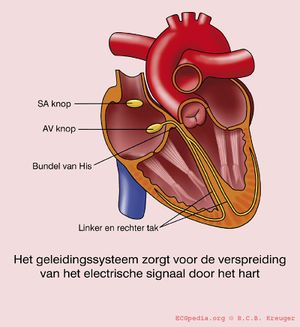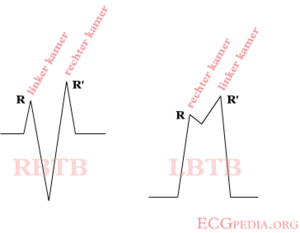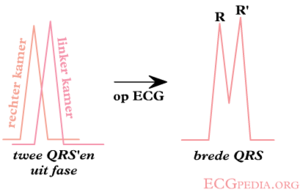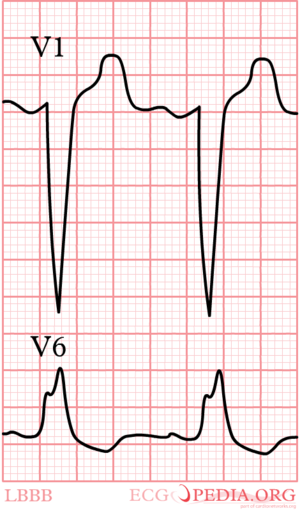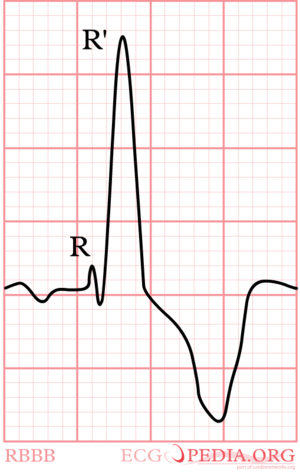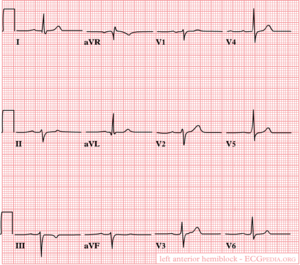Intraventricular Conduction: Difference between revisions
| Line 45: | Line 45: | ||
===Criteria for LAFB=== | ===Criteria for LAFB=== | ||
In left aBij een linker anterior fascie blok is de voorste bundel van de twee linker bundels geblokkeerd. Hierdoor wordt de voorwand als laatste ontladen. Dit uit zich in een linker asdraai. De QRS-duur is <0,12 seconde. | |||
asdeviatie naar links (<-30°); | asdeviatie naar links (<-30°); | ||
geen of vrijwel geen S in I alwaar normale kleine q; | geen of vrijwel geen S in I alwaar normale kleine q; | ||
Revision as of 17:33, 20 May 2007
| Author(s) | J.S.S.G. de Jong, MD | |
| Moderator | J.S.S.G. de Jong, MD | |
| Supervisor | ||
| some notes about authorship | ||
Conduction delay
If the QRS complex is wider than 0.12 seconds this is mostly caused by a delay in the conduction tissue of one of the bundle branches:
- Left Bundle Branch Block (LBBB))
- Right Bundle Branch Block(RBBB)
- Interventricular conduction delay
A right or left axis rotation can be caused by a:
Sometimes this conduction delay is frequency-dependent : the bundle branch block occurs only at higher heart rates and disappears at slower heart rates.
LBBB vs RBBB
Check V1 for QRS > 0,12 sec.
When the last QRS in V1 is below the baseline (moving away from V1), a LBBB is the most likely diagnosis.
When the last activity is above the baseline, it's a RBBB.
If the QRS > 0.12 sec. but the morphological criteria of LBBB or RBBB do not apply, it is called 'interventriculair conduction delay', a general term.
LBBB
- Left Bundle Branch Block
- QRS >0,12 sec with a broad R in I, aVL, V5 and V6 and missing Q wave.
In left bundle branch block (LBBB) the conduction in the left bundle is slow. This results in delayed depolarisation of the left ventricle, especially the left lateral wall. The electrical activity in the left lateral wall is unopposed by the usual right ventricular electrical activity. The last activity on the ECG thus goes to the left or away from V1. Once you remember this, LBBB is easy to understand.
Right bundle branch block
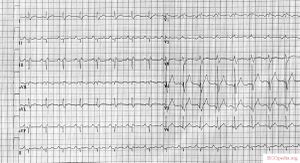
- Right bundle branch block (RBBB)
- QRS >0,12 sec. Positive QRS complex in V1, often with RSR'-pattern where R' > R.
Again, watch V1. In right bundle branch block (RBBB) the conduction in the bundle to the right ventricle is slow. As the right ventricles depolarizes, the left ventricle is often halfway finished and few counteracting electrical activity is left. The last electrical activity is thus to the right, or towards lead V1. In RBBB the QRS complex in V1 is allways markedly positive.
Criteria for LAFB
In left aBij een linker anterior fascie blok is de voorste bundel van de twee linker bundels geblokkeerd. Hierdoor wordt de voorwand als laatste ontladen. Dit uit zich in een linker asdraai. De QRS-duur is <0,12 seconde.
asdeviatie naar links (<-30°); geen of vrijwel geen S in I alwaar normale kleine q; S >R in II, III; QRS niet of slechts in geringe mate verbreed.
Criteria for LPFB
Criteria voor een posterior fascie blok:
asdeviatie naar rechts >+120°; diepe S in I; kleine q in III; QRS niet of slechts in geringe mate verbreed; criteria voor RVH of oud lateraal myocardinfarct mogen niet aanwezig zijn.
